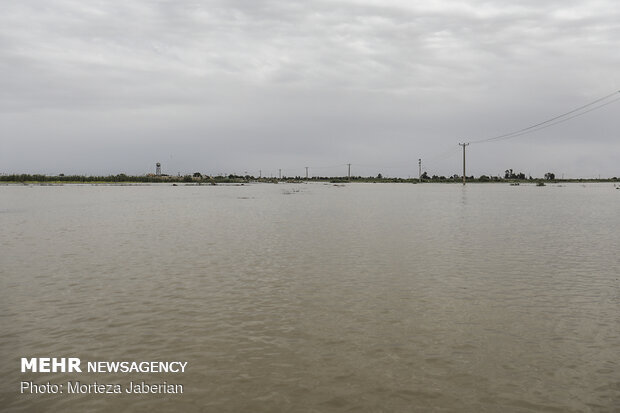River flood swamps Sassanid-era dam in southwest Iran

TEHRAN – The rain-swollen river of Karun has submerged a significant ancient dam in southwest Iran. The Sassanid era (224–651) monument is one of the satellite sites situated adjacent to the UNESCO-registered Shushtar Historical Hydraulic System in Khuzestan province.
Water rose to the maximum height of Mizan (Valerian) Dam as Karun River overflowed its banks caused due to heavy rains, a phenomenon that the director of the World Heritage site calls as “natural.”
“No abnormalities have occurred in Mizan [Dam],” Mohammadreza Bahadori said on Monday.
“Due to the location and nature of Mizan Dam, it is quite natural for this dam to be submerged.”
“The nature of the Mizan dam is to divide and regulate water for Gargar River (a tributary stream branched from Karun) and this way, Mizan is considered a regulatory dam,” the official explained.
“It could occur several times a year after the [heavy] rains…..and for the time being we are waiting to have calm weather to start a dredging operation immediately after the conditions return to normal.”
The UNESCO-tagged Historical Hydraulic System involves the creation of two main diversion canals on the river Karun one of which, Gargar canal, is still in use providing water to the city of Shushtar via a series of tunnels that supply water to mills.
The ensemble, as a whole, demonstrates outstanding universal value as in its present form, it dates from the 3rd century CE, probably on older bases from the 5th century BC.
It forms a spectacular cliff from which water cascades into a downstream basin. It then enters the plain situated south of the city where it has enabled the planting of orchards and farming over an area of 40,000 ha. known as Mianab (Paradise).
The property has an ensemble of remarkable sites including the Salasel Castel, the operation center of the entire hydraulic system, the tower where the water level is measured, damns, bridges, basins, and mills. It bears witness to the know-how of the Elamites and Mesopotamians as well as more recent Nabatean expertise and Roman building influence.
The Shushtar system, according to UNESCO, is as rich in its diversity of civil engineering structures and its constructions as in the diversity of its uses (urban water supply, mills, irrigation, river transport, and defensive system). It also testifies to the heritage and the synthesis of earlier Elamite and Mesopotamian knowhow; it was probably influenced by the Petra dam and tunnel and by Roman civil engineering.
AFM/
Leave a Comment